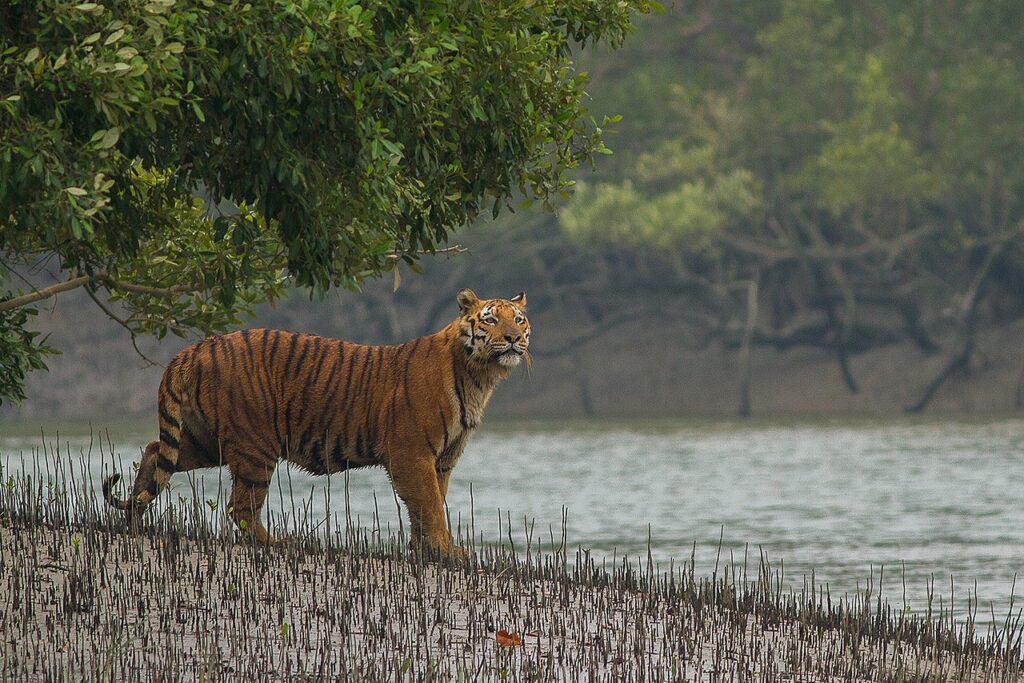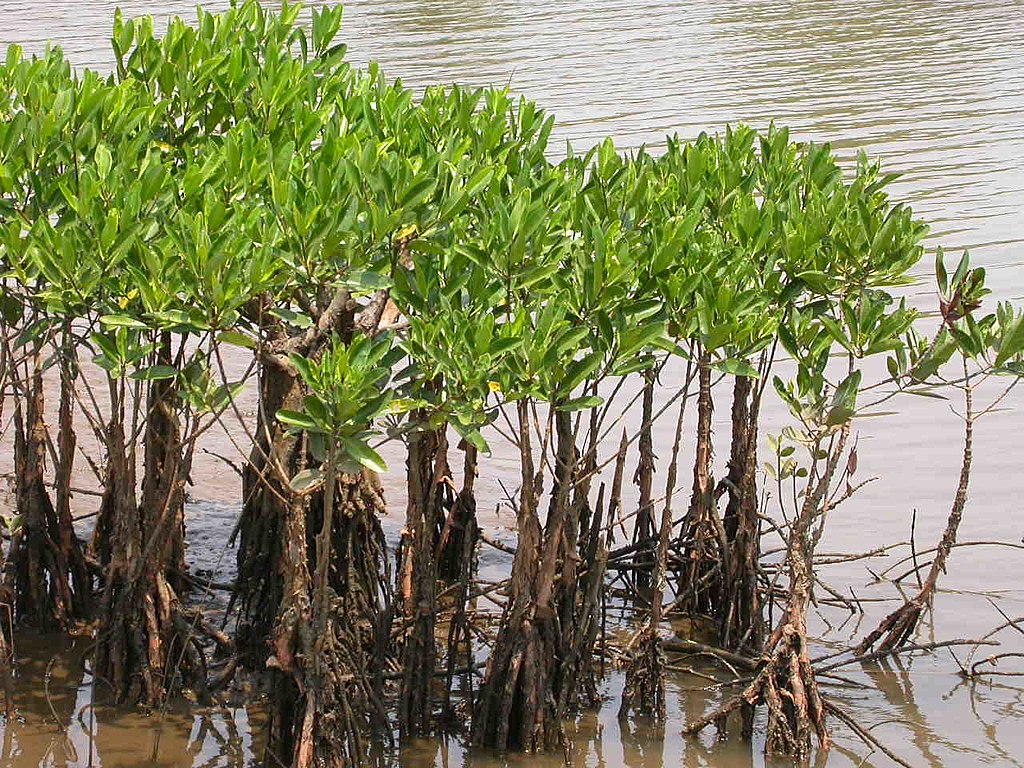Mangrove forests are a group of woody halophytic floral communities (Hussain & Badola 2003) having the ability to adapt to the extreme transitional zone. They embody divergent habitats between marine and terrestrial environments. Mangroves form one of the most productive ecosystems in the world and are major carbon sinks. (Ribeiro et al. 2019) These ecosystems form nutrient rich habitats for fishes, prawns and crabs which are important prey sources for the Fishing cats and Smooth-Coated Otters.

Mangroves of South and Southeast Asia account for 41.4% of the world’s mangroves of over 18 million ha (Spalding et al. 1997). Mangroves perform wide range of ecological functions like acting as protecting barriers in coastal belts withstanding the wave and storm surge onrush during storms and cyclones (Behera et al. 2011), prevention of salt interaction, providing nurseries for juvenile fishes, nutrient cycling, hydrological regime, stabilizing coastal sediments, aiding in delta formation process, fish-fauna production, trapping pollutants (Lee et al. 2014). The economic value of Mangroves of South-east Asia is estimated at $239–4,185 per hectare annually (Brander et al. 2012).
Mangroves are considered as a valuable resource for the coastal communities for getting honey, medicinal plants, tanning materials and wood for domestic purposes, and provides livelihood opportunities to coastal communities and are thus these ecosystems are highly threatened due to competition for resources with humans, such as land, water and fish. Survey shows that over 50 percent of Asian wetlands are facing moderate to high degrees of threat, which includes human settlement, drainage for agriculture, effluence, and excessive hunting, wood-cutting and excessive fishing (Nowell & Jackson 1996; Dahal & Dahal 2011).
Antropogenic Disturbances prove costly for Mangroves
Disturbance has an important impact on mangrove forest dynamics (Lugo & Snedaker 1974; Smith 1992). Anthropogenic disturbances in mangroves tend to have a higher frequency and intensity (Jime´nez et al. 1985). However, the extent of damage and speed of recovery are functions of the intensity, persistence, and periodicity of forest disturbance, as well as the forest type affected (Jime´nez et al. 1985).
Mangrove ecosystems comprises biologically important ecosystems in nature and one of the most threatened ecosystems (Giri et al. 2011; Sandilyan & Kathiresan 2012). An important function of mangrove ecosystems in protection against coastal disasters (Das & Vincent, 2009). Additionally, mangroves sequester up to 5.5 million tons of carbon per year (EOng 1993). Furthermore, mangroves. provide oceans with more than 10% of their essential organic carbon (Dittmar et al. 2006); they are considered environments of intense carbon flux (Siikamakia et al. 2012). Unsurprisingly, several coastline economies rely on mangrove forests. In fact, mangroves provide at least 1.6 billion USD in “ecosystem services” each year. (Costanza et al. 1997).
It is estimated that nearly 80% of all global fish catches are directly or indirectly dependent on mangroves (Ellison, 2008; Polidoro et al. 2010). Almost half of the global population live within 150 km of a coastline (Cohen et al. 1997); thus, anthropogenic influences strongly affect mangrove ecosystems. Band width of 500 m is the niche preference of different mangrove species (Saha et al. 2018).
The State of the World’s Mangrove Forests
The global area of mangrove forests has been reduced by more than half. Additionally, most of what remains shows high levels of degradation (Spiers 1999; Spalding et al. 2010). Approximately 35% of all mangrove trees were lost between 1980 and 2000. In fact, mangrove forests have been declining at a faster rate than both inland tropical forests and coral reefs (Duke et al. 2007). In the last 40 years, the area covered by the mangrove ecosystem has shrunk by more than half. (Beys-da-Silva et al. 2014).

Recent predictions suggest that 100% of mangrove forests could be lost in the next 100 years if the present rate of loss continues (Duke et al. 2007). Consequently, important ecosystem products and services that are provided by mangrove forests will be diminished or completely lost (Giri et al. 2011).
During last two decades, numerous analytical activities ranging from site specific to synergistic and cumulative effects, have come to floor in the sector of forestry and wildlife (Allen & Starr 1982; Urban et al. 1987; Hobbs 1988). The development of indices to quantify landscape patterns for the purpose of understanding pattern-process interactions has been prioritised. (O’Neill et al. 1988, Turner 1990, Turner & Gardner 1991, Baker & Cai 1992, Garigal & Marks 1995). These landscape measures make it easier to comprehend and visualise the shifting pattern and its impact on processes that would otherwise be obscure. Various types of remote sensing data Spatiotemporal specification and GIS of various levels of complexity have developed as valuable tools for addressing landscape level research concerns.
Potential Mitigation
- Involving local community in conserving these unique ecosystems.
- Promoting and supporting education and awareness campaigns.
- Providing alternative livelihood facilities to local communities.
- Monitoring the habitat in regular intervals.
- Motivating the youth for using the natural resources in a sustainable way.
- Educating and training people about the significance of the unique biota of mangroves.
- Conducting local level surveys and research studies
- Enforcement of the concerned managemental sector.
- Framing short-term and long-term area specific strategies.
- Conserving keystone species in this habitat.
- Planning Restoration activities in degraded habitats. This includes scientific plantations in mangrove forests.
This article was written by Shreya Pandey
Help us Help Them! Think Wildlife Foundation is a non profit organization with various conservation initiatives. Our most prominent campaign is our Caring for Pari intiative. Pari is a rehabilitated elephant at the Wildlife SoS Hospital. 25% of the profits from our store are donated to the elephant hospital for Pari. Other than buying our wonderful merchandise, you could donate directly to our Caring For Pari fundraiser.
